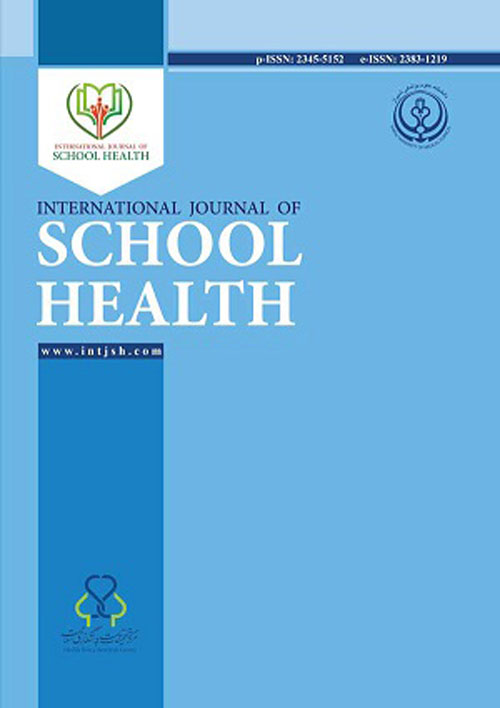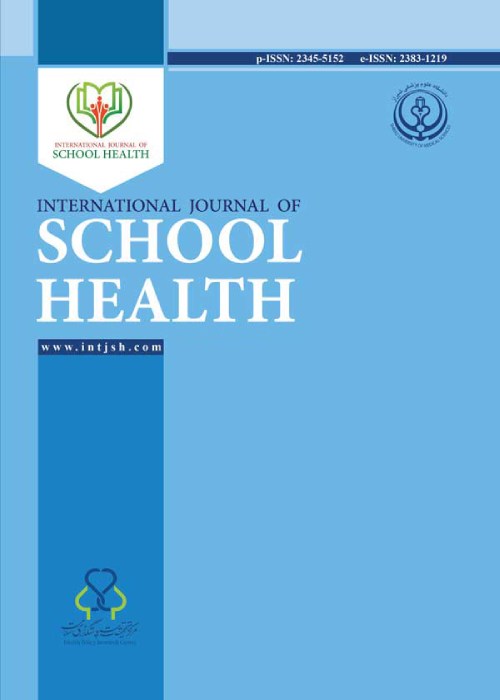فهرست مطالب

International Journal of School Health
Volume:3 Issue: 3, Summer 2016
- تاریخ انتشار: 1395/05/02
- تعداد عناوین: 8
-
-
Page 1BackgroundAttitudes are very important in the formation of behaviors. Parents attitudes toward children and behaviors with them are the main causes of child abuse. Identifying these attitudes and their related factors can be the primary basic action for prevention of child abuse.ObjectivesThis study was conducted to investigate the parents attitudes toward child abuse in the health centers of Tabriz.
Patients andMethodsIn this cross-sectional study 384 parents with children 2 to 12 years old, filled a questionnaire about parents attitude toward child abuse in the 13 health centers of Tabriz. Data was analyzed using SPSS (version 16.0).ResultsThe results showed that the mean score of total attitude toward child abuse was significantly higher than the middle (PConclusionsThe results showed that the parents attitudes toward child abuse were negative, but because of the relationship between parents attitudes with some of their demographic characteristics, parents should be supported economically and socially to prevention of child abuse.Keywords: Parents, Child Abuse, Attitude -
Page 2BackgroundPsychological factors are among the most influential parameters in education. Among these effective traits, personal features centering around the self, have been of utmost importance specially in ones future of education and psychological well-being. Due to their critical period of life in terms of cognitive development, teenagers are subject to considerable academic and mental transformation at school.ObjectivesThe aim of the present study was to predict life satisfaction and academic performance based on locus of control and self-esteem among school students.
Patients andMethodsOverall, 315 high school first-grade students (143 girls and 172 boys) were chosen from an Iranian city using random cluster sampling and responded to three scales of self-esteem (RSES; Rosenberg, 1965), locus of control (SCS; Ingels et al. 1992) and brief multi-dimensional students Life satisfaction scale (BMSLSS; Seligson, Huebner et al. 2003). Moreover, academic performance was measured via the students total score average in the second semester of 2014 - 2015 academic year.ResultsUsing Pearsons correlation coefficients and multi-variate analysis (stepwise regression method), the data analysis indicated that locus of control and self-esteem have a positive relationship with life satisfaction and predict twenty-five percent of variance changes of the variable. In addition, the results showed that the variables of locus of control and self-esteem have a positive and significant relationship with academic achievement and these two variables characterize eleven percent of the academic achievement variance changes.ConclusionsIn conclusion, the findings of this study revealed that locus of control and self-esteem play crucial roles in developing students life satisfaction and academic performance.Keywords: Life Satisfaction, Academic Performance, Locus of Control, Self, Esteem -
Page 3BackgroundA child with a language impairment in the absence of significant sensory, psychiatric, neurological, or intellectual disorders should be diagnosed as having a specific language impairment (SLI). Data regarding the prevalence of SLI are rare and vary widely. A number of studies have been conducted in order to determine the prevalence of SLI in different populations. However, the prevalence of child language disorders in an Iranian population is unknown due to the limited epidemiologic studies in the field. In addition, many studies have found that children with SLI are at risk for social, behavioral, emotional, and educational difficulties.ObjectivesThe aim of this study was to estimate the prevalence of specific language impairment in 6-year-old Persian-speaking children.
Patients andMethodsThis research was an epidemiological study conducted over a three-month period in the summer of 2015 in Shiraz. The sample size was 180 children aged 6 years that included 95 boys and 85 girls who were recruited from 10 preschool centers in 9 urban areas in Shiraz using stratified sampling. The EpiSLI system was used to diagnose SLI. The Persian version of the test of language development (TOLD-P: 3) was employed to evaluate the childrens oral language skills. A number of descriptive statistics was employed, such as rates, mean, and standard deviation. In addition, the Chi-square test was used to analyze the correlation between the prevalence of SLI with sex and area at a significance level of 0.05.ResultsThis study estimated the prevalence of SLI in 6-year-old Persian-speaking children to be 2.7%. In addition, the estimated prevalence rates of SLI in boys and girls were 2% and 3.5%, respectively. Also, there was no significant correlation between the estimated prevalence of SLI with sex and area (P > 0.05).ConclusionsAccording to the findings of this study, 2.7% of the 6-year-old Persian-speaking children living in urban areas of Shiraz and enrolling at preschool centers have a specific language impairment. Therefore, it is important to employ a screening system to identify these preschool children in order to prevent subsequent problems in school-aged children.Keywords: Prevalence, Specific Language Impairment, Speech Disorders, Child, Preschool -
Page 4BackgroundIn all ages, people capitalize on different aspects of their body. A number of studies have indicated the relationship between mindfulness and body image.ObjectivesThe aim of this study was to investigate the relationship between cosmetic surgery tendency and mindfulness, personality-dimensions, perfectionism and mental health among female high school students in Isfahan.Materials And MethodsThe population consisted of all female high school students who were enrolled in Isfahan high schools in academic year of 2014 - 2015. Two hundred students were randomly selected from six educational districts in Isfahan city, Iran. Personality inventory (NEO-PI-R), multidimensional body-self relations questionnaire (Kims), multidimensional perfectionism scale (MPS) and general health questionnaire (GHQ-28) were used to collect data. Pearson correlation, multiple regression analysis were used for data analysis.ResultsThe results showed that the correlation between cosmetic surgery and mindfulness was -0.68. Also, correlation coefficients of cosmetic surgery and personality-dimensions, mental health and perfectionism were 0.62, 0.57 and 0.20, respectively (PConclusionsAccording to these results, individuals who have depressive and perfectionism tendencies are not flexible in their thoughts and emotions, and cannot accept their body as it is, without judgment and with unconditional. Also, those who have closed personality with negative evaluations of their appearance are more likely to seek cosmetic surgery. Regarding the effectiveness of psychological factors in tendency towards the cosmetic surgery, it is better to refer patients to the psychological and mental health centers and take a test to determine whether the problem is mindfulness or other variables.Keywords: Cosmetic Surgery Tendency, Mindfulness, Personality
-
Page 5BackgroundSocial robots may represent an important technological instrument for improving the social abilities of children with autism spectrum disorders (ASD).ObjectivesThis work describes exploratory research in which a doctor game scenario, involving a social robot and a human partner, was implemented and tested with children with ASD.
Patients andMethodsThirty children between the ages of four and eight who had been diagnosed with ASD were included in this study. The children alternated between playing a doctor game with the social robot Probo and playing the same game with a human partner, and were exposed to each condition only once in a counter-balanced order. The symbolic play task and the experimental setup were designed to test whether the children would engage in more collaborative behaviors while playing the doctor game with a social robot than performing the same activities with the human partner.ResultsAlthough the children with ASD were more interested in and entertained by the robotic partner, the children did not have better performance in the game, and did not show significantly more collaborative play and engagement while playing with the social robot, compared with the human partner.ConclusionsA longer and more thorough study is needed to interpret these findings and better understand the ASD child-robot interaction. This paper concludes with a discussion of the related literature and proposals for future research directions.Keywords: Robot, Assisted Therapy, Autism Spectrum Disorders, Social Robot, Symbolic Play, Collaborative Play -
Page 6BackgroundLearning is a phenomenon that has interested humans for a long time. Research on the factors influencing learning has always interested psychologists and all those dealing with education, particularly sports coaches.ObjectivesThis study aimed to investigate the impact of goal setting on learning a skill targeting 10-year-old boys.
Patients andMethodsFor this purpose, forty 10-year-old male children were selected as the study sample and were assigned to one of two groups: goal-setting (n = 20) and non-goal setting (n = 20) groups. In the acquisition phase, each group participated in 8 sessions for 8 continuous days, and then participants in each group conducted 40 (4 blocks of 10 attempts per session) attempts separately. Finally, after 24 hours, the groups performed a retention test. The scores of each group at each phase were obtained and compared using ANOVAs and independent t-tests.ResultsThe results of the statistical analysis did not show differences in the acquisition phase between the two groups (P > 0.05). In the retention phase, there was a significant difference between the two groups, and this advantage was in favor of the goal-setting group (PConclusionsIn general, it is recommended that teachers and sports coaches use goal setting when teaching skills to children.Keywords: Learning, Acquisition, Retention, Goal Setting, Children, Throwing Skills Over Shoulder -
Page 7BackgroundAdolescence period is characterized by life threatening behaviors such as using psychoactive substances. However, the adverse effects of using psychoactive substances may include cirrhosis of the liver, lung cancers, and chronic illnesses.ObjectivesTo investigate the awareness and use of psychoactive substances among secondary school adolescents living in the Niger Delta region of Nigeria.Materials And MethodsThe study method was cross-sectional with descriptive survey design. The research population was all secondary schools students (N = 16973) of Nigeria. A multistage sampling procedure was used in selecting a sample size of 2000 participants. A modified WHO student drug use questionnaire on awareness and use of psychoactive substances by secondary school students was used for data collection. Also, relevant hypotheses were formulated and frequency counts, percentages, and Chi-square test were used for statistical analysis.ResultsThe results showed that a high number of study participants were aware of psychoactive substances but a relatively low number actually used them. Alcohol was the most abused form of psychoactive substance.ConclusionsAn appropriate psychoactive drug education program should be included in the curriculum of primary and secondary schools.Keywords: Psychoactive Substances, Awareness, Use, Adverse Effects
-
Page 8BackgroundAdopting caring behaviors in adolescence is very important since alcohol and drug use among teenagers has become a pressing social problem and is also a predictor of school drop-out rates and academic failure. Research has shown that there is lack of awareness about drug and alcohol use.ObjectivesThe present study describes a psycho-social strengthening program aimed at changing female students attitudes toward drug use.
Patients andMethodsThe research design involved an experimental group that participated in a pre-test and post-test, as well as a control group. The study population comprised female students in the first grade of high school in Tehran city during the educational year 2014 - 2015. Random cluster sampling was used to select 60 students in total. Mohammad Khanis (2006) risk and protective factors questionnaire (RAPQ) was used to collect the data. The treatment group participated in the united nations office on drugs and crime (UNDOC) psycho-social strengthening program in the schools package over eleven 90-minute sessions. Covariance analysis was used to analyze the data.ResultsThe significance of covariance F at the level of PConclusionsGiven the importance of caring about high-risk behaviors and the role of psycho-social strengthening in changing female students attitudes toward drug use, it is better to carry out such interventions at an early age in school to ensure more preventative and sustainable effects.Keywords: Psycho, Social Strengthening, Attitude, Attitudes Toward Drug Use, Risk Factors, Iranian Students


